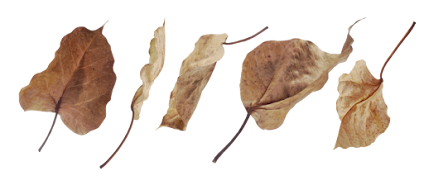The Hidden World Beneath Fallen
Leaves
When autumn
descends, a stunning transformation occurs within forests and woodlands. The
vibrant hues of gold, orange, and crimson blanket the ground as leaves detach
from trees, creating a thick layer of organic matter. While many admire the
aesthetic beauty of a leaf-strewn landscape, there lies a hidden world beneath
this seemingly simple façade. This essay delves into the myriad ecological,
biological, and chemical processes that take place beneath fallen leaves,
highlighting their significance in sustaining ecosystems, supporting
biodiversity, and enhancing soil health.
The Process of Leaf Fall: Ecology in Transition
The phenomenon of leaf fall, or abscission, is not merely an end, but rather a vital part of the life cycle of deciduous trees. As daylight diminishes and temperatures drop in autumn, trees undergo physiological changes that signal the cessation of photosynthesis. Trees prepare for winter by shedding their leaves, thereby conserving water and energy. The dead leaves that collect on the forest floor then serve multiple ecological purposes as they interact with various biotic and abiotic factors.
Decomposition: Nature's Recycling Process
One of the most critical processes occurring beneath fallen leaves is decomposition. This process is driven by fungi, bacteria, and a multitude of detritivores, including insects and microorganisms, which break down the organic material into simpler compounds. Decomposition occurs in several stages:
1. Leaching: Initially, rainwater seeps through the leaf litter, dissolving soluble nutrients and leaching them into the soil.
2. Fragmentation: Larger decomposers, such as earthworms and arthropods, shred the leaves into smaller pieces. This fragmentation increases the surface area for microbial action, making decomposition more efficient.
3. Chemical Breakdown: Fungi and bacteria secrete enzymes that break down complex organic polymers in leaves, leading to the release of nutrients such as nitrogen, phosphorus, and potassium back into the soil.
The Role of Leaf Litter in Biodiversity
The leaf litter layer is one of the most biodiverse habitats in terrestrial ecosystems. It offers a microhabitat for countless organisms that thrive under its surface. Some key inhabitants of this hidden world include:
- Invertebrates: Various arthropods, such as beetles, spiders, and centipedes, rely on the leaf litter for food and shelter. Many species of ants, for example, create their nests in the litter and forage for decaying organic material.
- Fungi and Bacteria: These microorganisms play a crucial role in decomposition and nutrient cycling. They also form symbiotic relationships with plant roots, enhancing nutrient uptake through mycorrhizal networks.
- Small Mammals and Birds: Ground-dwelling mammals, such as shrews and voles, forage for seeds and invertebrates among the leaf litter, while certain bird species hunt for insects residing within.
The leaf layer acts as a nursery for several life stages of these organisms, supporting both their survival and the greater food web. The energetic pathways initiated by detritivores contribute to the overall health of the ecosystem, maintaining its resilience and adaptability.
Hydrological Benefits of Leaf Accumulation
Fallen leaves play a crucial role in influencing hydrological cycles in ecosystems. The leaf litter layer acts as a natural sponge, absorbing rainfall and enhancing groundwater recharge. This absorption helps to mitigate surface runoff, thereby reducing soil erosion. In forest ecosystems, maintaining leaf litter is vital for protecting the delicate balance of natural water cycles and alleviating flooding risks downstream.
The Influence of Leaf Composition
Not all leaves are created equal; the composition of leaf litter can influence the types of organisms that thrive beneath it. Leaves from different tree species decompose at varying rates and have distinct biochemical properties. For example, oak leaves, which are rich in tannins, decompose more slowly than softer leaves from species such as maples. This variation contributes to the diversity of habitats underneath fallen leaves. In forest ecology, understanding leaf litter composition is essential for managing forest health and biodiversity.
Human Interaction and Ecological Considerations
With growing awareness of environmental conservation, the significance of fallen leaves has gained attention in land management and gardening practices. Rather than raking and disposing of fallen leaves, many ecologists advocate for leaving them intact. Practices such as "litter mulching" recycle nutrients back into the soil, enriching gardens and promoting biodiversity.
Moreover, urban planners and landscape designers are beginning to recognize the importance of preserving leaf litter within public parks and green spaces. By understanding the interconnectedness of soil, water, and leaf litter, communities can work to develop more sustainable environments.
The hidden world beneath fallen leaves represents a complex and dynamic ecosystem that plays a critical role in maintaining environmental health and biodiversity. From facilitating decomposition and enriching soil to providing habitats for countless organisms, fallen leaves are far more than mere waste; they are foundational to ecological processes. As we continue to explore and understand the interdependencies within ecosystems, we must embrace the lessons taught by nature, finding ways to coexist sustainably and honor the intricate connections that sustain life beneath the surface. The fallen leaves of autumn, therefore, should be seen not just as a seasonal change, but as a vital component of the living tapestry of our natural world.
.jfif)

.jfif)
.jfif)

